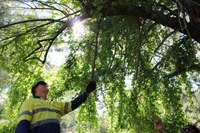A Key Part of the Araluen Creek Restoration Project - Weed Management
A key component of the Upper Deua Catchment Landcare Group’s (UDCLG) Araluen Creek Restoration Project is controlling weeds and a Weed Management Plan was prepared in 2021. The survey assessed weeds along the Araluen Creek riparian zone from Bridge to Bridge (refer map below). This included presence, abundance, and classification of weed species within individual properties. Ninety-one sites were assessed. The report included recommendations for eradication, control and remediation of the various weeds.
The Araluen Creek Weed Management Plan project area extends between Majors Creek Mountain Road bridge in the north and Neringla Bridge in the south. The survey identified 17 species of weeds including:
- 2 weeds of National Significance
- 2 State Priority weeds
- 17 environmental weeds
- 1 Local Management Programs weed
- 1 Declared pest plant (ACT)
The most significant woody weed species identified within the Weed Management Project area are:
- African Boxthorn (Lycium ferocissimum) a Weed of National Significance, which was recorded within 64 of the 91 survey sections (70%).
- Broad-leaved Privet (Ligustrum lucidum) an Environmental Weed, which was recorded within 71 of the 91 (78%) survey sections.
- Small-leaved Privet (Ligustrum sinense) an Environmental Weed, which was recorded within 60 of the 91 survey sections (67%).
- Blackberry (Rubus fruticosus species aggregate) a Weed of National Significance, which was recorded within 19 of the 91 survey sections (21%).
The presence of a range of growth stages (i.e. seedling to maturity) of African Boxthorn, Broadleaved Privet and Small-leaved Privet indicate that the infestation of these weeds is actively increasing.
Map of Weed Management Plan Area along the Araluen Creek
Landscape Ecology
Daniel Anderson from Apical Bushfire and Planning had the following advice for the group:
The control or eradication of invasive plants must be undertaken with strategic foresight. All activities must be carefully planned to ensure clear targets can be achieved, and that efforts are directed towards the most beneficial and achievable outcomes for a given project objective at a given point in time.
Refer to your weed management plan - adapt and modify. Update the plan to represent the project progressions.
Nothing in ecological science is static. Conceptualize the orders of cause and effect – all inputs create outputs, feedback loops and change thresholds are real and can be measured in biological science. To this end, focus the inputs (effort, resources, investments) into activities that are achievable and measurable. Only start actions that can be finished and only start actions that can deliver a defined goal. Think about successional processes or what comes next. If we intervene in a cycle or trend – then we must change a threshold to achieve a sustainable reward.
Weed control – is a function of stopping the spread of unwanted plants. We can measure this by weed extent, cover, and presence.
Weed Eradication – is a function of changing thresholds in the landscape, replacing a trend or dominant weeds species with something different. Weed eradication has multiple phases and must lead to a new pattern of plant interactions in the landscape to be successful.
Landscape Restoration – is a function of successfully integrating several key actions to influence the balance of interactions (feedbacks – relationships) in a system that creates a new or novel desired balance. Landscape restoration in effect is the sum of all parts and should be measured in qualitative terms. What is the quality of our creations with regard to things like habitat, biodiversity, water quality, soil health, species diversity, local climate and overall resilience?
For the extended summary please see Weed Management: A key part of the Araluen Creek Restoration Project (2022)
Also see these useful tips from Daniel Anderson on how to manage:
Soon to be available Araluen Creek Weed Management Plan (2021)
Article was an excerpt of the report prepared by Clare Henderson and Daniel Anderson.
This is a Bushfire Community Recovery and Resilience Fund project through the joint Commonwealth/State Disaster Recovery Funding Arrangement







